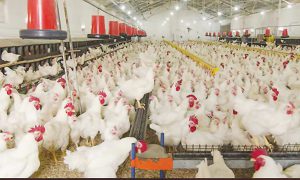It feels like Singapore has only just switched from combating the pandemic, with some of the developed world’s strictest curbs, to plunging headlong into a fight against inflation. The central bank tightened policy three times since late last year. Now, the highly urbanised island that imports most of what it eats has a front-row seat to food
nationalism. Neighbouring Malaysia, from which Singapore gets a third of its poultry, is banning chicken exports starting soon, citing domestic shortages and price spikes.
While the imminent embargo is often framed as dour news for fans of hawker-center dishes like chicken rice, more consequential risks lurk in the background. Singapore gets many of its building blocks of modern life from its northern neighbour: power, water, labour and food. While the government has worked hard over the years to reduce dependence on agricultural imports, with kale farms inside former industrial warehouses and fisheries springing up on vacant lots, food security is a long term project.
The more protectionist, politically contested world we now inhabit brings real challenges for Singapore. Not only does the city-state need to worry about availability of supplies — as it did during border closures early in the pandemic — but how lower stocks will accelerate rapid price increases that have affected every corner of life, from fuel and electricity bills to rent and groceries. Channel News Asia, a local network, recently profiled a family that cut shower time in half because of climbing utility costs. Core inflation is the highest in a decade.
The full impact of the ban isn’t yet apparent. The poultry section at a Cold Storage supermarket on Orchard Road had been cleaned out. By contrast, the shelves at a Fairprice supermarket in the northern suburb of Punggol were full — the bulk of chicken from Malaysia. Still, it was hard to miss the sign urging shoppers to purchase no more than required, consider protein substitutes, and be patient and responsible, while the store works on securing more stock. The government also says it has built up critical supplies of food and there is no need to panic. (Other sources of chicken include Brazil, Australia and the US.)
It’s clear that any potential shortage is a small part of a larger battle. “This time it is chicken, next time it may be something else,†Prime Minister Lee Hsien Loong told reporters. “We have to be prepared for this. It’s a very unsettled world and inflation is a problem, cost of living is a problem but in the scheme of things, many more disruptive things can happen than just some price adjustments. And we are seeing some of that now.â€
Malaysia, for its part, is facing the toxic mix of rising demand as feed and fertiliser costs soar, thanks to Russia’s invasion of Ukraine. Chicken farmers claim they are being squeezed and will have to scale back production. Poultry isn’t a big export, but if the government adopted the same tactics for more significant products, like palm oil, the consequences would be much more severe.
That doesn’t bode well for buyers of the country’s fish and vegetables. Nor is Malaysia the only culprit of protectionism in the region. India plans to restrict sugar exports after barring wheat sales, and Indonesia blocked — then unblocked — foreign exports of palm oil. Thailand’s premier says his country should join forces with Vietnam to jointly raise rice prices to buttress their bargaining power.
Preparations for extreme weather could be exacerbating the trend.
—Bloomberg
 The Gulf Time Newspaper One of the finest business newspapers in the UAE brought to you by our professional writers and editors.
The Gulf Time Newspaper One of the finest business newspapers in the UAE brought to you by our professional writers and editors.
